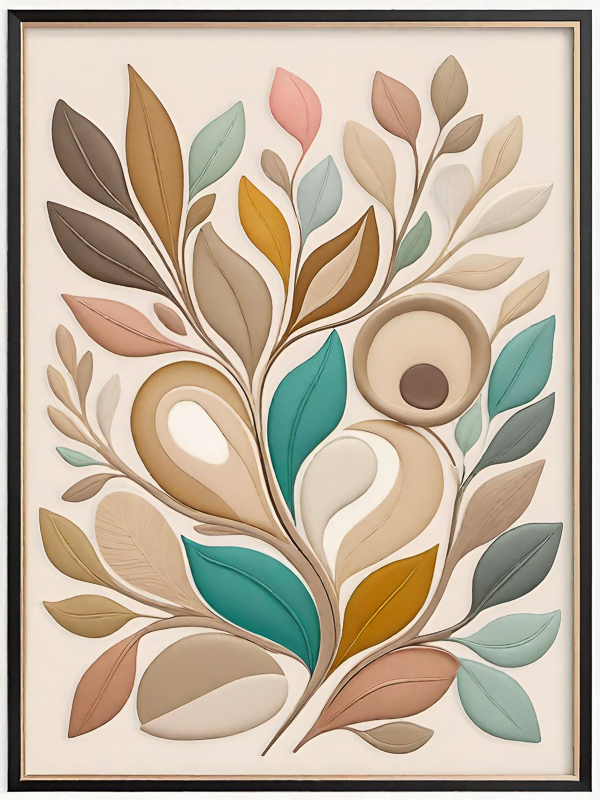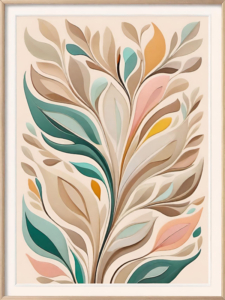Japandi Art
Japandi, as the name suggests, is a mix of Japanese and Scandinavian styles. It is influenced by the ancient Japanese philosophy of wabi-sabi, a way of life that values slow living, contentment, and simplicity, as well as the Scandinavian practice of hygge, which embraces comfort, coziness, and well-being.
What is Japandi art?
“Japandi” refers to a design style that combines elements of Japanese minimalism with Scandinavian design principles. It emerged as a fusion of two popular design aesthetics: Japanese design, known for its simplicity, natural materials, and attention to detail, and Scandinavian design, characterized by clean lines, functionality, and a focus on light and airy spaces.
Japandi art, within the context of this design style, often reflects the principles of both Japanese and Scandinavian aesthetics. Common features include:
1. Simplicity: Japandi art tends to be minimalistic, with a focus on simplicity and functionality. It avoids unnecessary ornamentation and clutter.
2. Natural Materials: Both Japanese and Scandinavian design emphasize the use of natural materials such as wood, stone, and textiles. Japandi art often incorporates these materials to create a harmonious and organic feel.
3. Neutral Colors: A muted color palette is a key characteristic of Japandi design. Neutral tones, such as whites, grays, and earthy tones, are commonly used to create a calm and balanced atmosphere.
4. Balance and Harmony: Japandi art aims to achieve a sense of balance and harmony in its compositions. It may involve a careful arrangement of elements to create a visually pleasing and tranquil space.
5. Functional Design: Both Japanese and Scandinavian design prioritize functionality. Japandi art often includes furniture and decor items that are not only aesthetically pleasing but also serve practical purposes.
6. Craftsmanship: There is often an appreciation for craftsmanship and handmade elements in Japandi design. This reflects the attention to detail and the quality associated with both Japanese and Scandinavian design traditions.
Japandi has gained popularity as a design trend because it successfully merges the best aspects of two distinct styles, creating a unique and appealing aesthetic that resonates with those who appreciate a blend of simplicity, functionality, and natural beauty.
What is the difference between Japandi art and Bauhaus art?
Japandi art and Bauhaus art are two distinct design styles that originated in different cultural and historical contexts. While they share some common principles, there are notable differences between the two:
1. Cultural and Historical Roots:
– Japandi Art: Japandi is a fusion of Japanese and Scandinavian design aesthetics. It draws inspiration from the simplicity and nature-focused design of Japanese culture and the clean lines and functionalism of Scandinavian design.
– Bauhaus Art: Bauhaus was a German art school that operated from 1919 to 1933. It was a modernist movement that aimed to bridge the gap between art and industry. Bauhaus design principles emerged in the early 20th century and had a significant influence on modernist architecture and design.
2. Aesthetic Characteristics:
– Japandi Art: Emphasizes simplicity, natural materials, neutral colors, and a sense of balance and harmony. It often includes handcrafted elements and a focus on creating a serene and minimalist environment.
– Bauhaus Art: Focuses on the integration of art, craft, and technology. It often features clean lines, geometric shapes, and a rejection of unnecessary ornamentation. Bauhaus design aims for functional, practical solutions and the elimination of excess.
3. Materials and Craftsmanship:
– Japandi Art: Values natural materials like wood, stone, and textiles. There is often an emphasis on craftsmanship and handmade elements in Japandi design.
– Bauhaus Art: Embraces new industrial materials, such as steel and glass. While craftsmanship is important, Bauhaus also emphasizes the potential of mass production and the use of modern manufacturing techniques.
4. Color Palette:
– Japandi Art: Tends to use a muted and neutral color palette, with an emphasis on earthy tones, whites, and grays.
– Bauhaus Art: Initially, Bauhaus used a range of bold and primary colors in its early years. However, as the movement evolved, it also embraced a more subdued and neutral color palette.
5. Geographic Influence:
– Japandi Art: Reflects a blend of Japanese and Scandinavian design sensibilities, drawing from the aesthetics of both cultures.
– Bauhaus Art: Originated in Germany and had a significant impact on modernist design and architecture worldwide.
While both Japandi and Bauhaus design share a commitment to functionality, they differ in their cultural influences, aesthetic choices, and historical contexts. Japandi is a more recent fusion of styles, whereas Bauhaus emerged as a groundbreaking movement in the early 20th century.



